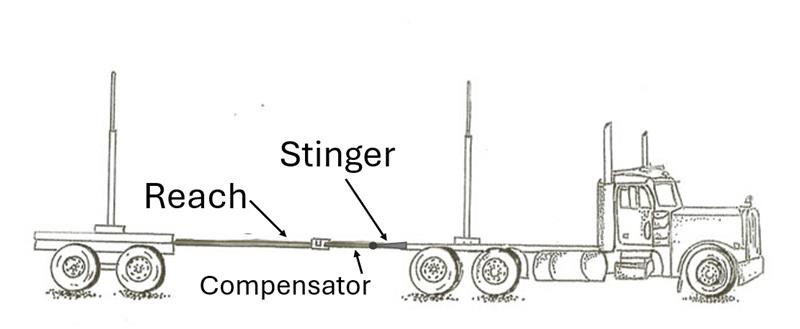Log Transport
The type of truck and trailer used to transport logs is dependent on the size of logs being transported, the condition of the roads, and regional preferences.
Tree Length Log Trucks
Full-length logs can be transported by stinger-steer log trailers or fixed length log trailers.
Pole trailers were designed to minimize the overall tare weight of the truck. It is limited to working with tree length material. The stems are not supported in the middle, just between the bolsters at either end.
The trailer is typically a set of double-axle wheels with a rotating bunk. As the truck turns the length of the stems is fixed between the bolsters, but the distance between the truck and trailer must elongate. The pole connector must therefore be telescoping. A slight variation on the pole trailer is the stinger-steer trailer, specifically designed for turning on roads with tight turning radii.
Stinger-steered log trucks consist of a truck with an extension to the back of the frame, this extension is called a stinger, with a pintle hitch. The trailer has an adjustable beam, called a reach, that consists of a bar that adjusts so that the distance between the truck and trailer can change as needed. The reach attaches to the stinger to complete the trailer.” A compensator sits inside the reach and allows the trailer to adjust when negotiating sharp curves. This configuration allows this log truck to negotiate tighter radius curves compared to other truck configurations.

Figure 1 - Truck and pole trailer.
Fixed length log trailers are simply a semi-trailer with bunks instead of a box. They do not have a floor, but one or more beams to support the bunks along the length of the trailer. They are capable of carrying tree length logs or multiple bunks of log length material. For transportation on public roads chains or straps will have to be used to secure the logs in the bunks from sliding or rolling off.

Figure 2 - Semi-truck double bunk trailer.
Log Length Log Trucks
Where only log length material is being transported, a straight truck with a trailer may be used. Often the straight truck has a loader mounted on the rear of the truck for self-loading.

Figure 3 - Semi-truck double bunk trailer.
Indexing logs on a log truck may be used to achieve the full capacity of the log truck. This is done by placing logs top to butt and is especially effective where the logs have high taper.

Figure 4 - Straight Truck with Indexed Load.

